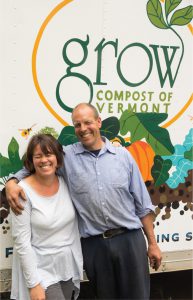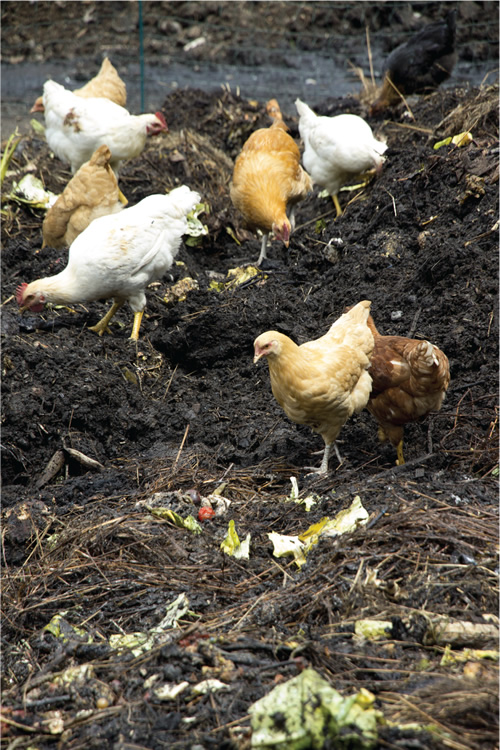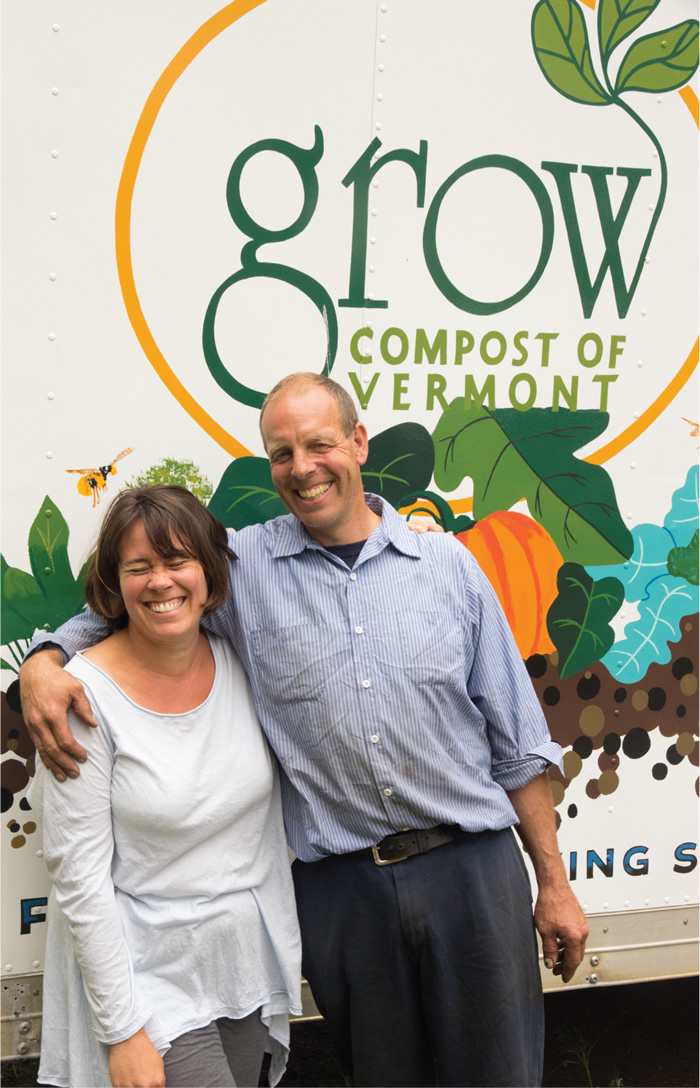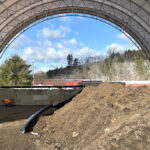The roll out of a new state recycling law, revised hierarchy for using food residuals, and change in permitting are dramatically affecting how a Vermont composting facility runs its business.
Molly Farrell Tucker
BioCycle September 2015

Lisa Ransom and Scott Baughman started Grow Compost in 2009.
The State of Vermont’s Act 148, which phases in a ban on landfill disposal of food waste, outlines a hierarchy of preferred ways to manage food scraps and food residuals. Under the hierarchy, these materials should first be source separated for food rescue, secondly used as animal feed, and thirdly used for composting and anaerobic digestion. This has meant a change in the way Grow Compost in Moretown, Vermont does business. “We are looking at the resources in our organics stream in a very different way than we did when we began in 2009,” says Lisa Ransom, who co-owns the business with her husband, Scott Baughman.
In 2009, Grow Compost was permitted through the Vermont Department of Environmental Conservation (DEC) to compost food scraps, farm waste, wood waste and leaves and yard trimmings. “Our business model has shifted from composting all of the feedstocks we receive, to using this hierarchy for food scraps,” explains Ransom. “We now work closely with food rescue organizations, farmers and anaerobic digesters throughout the state.”
Expanding Into Collection
Grow Compost began receiving food scraps in 2009 from an organics hauling service provided by the Central Vermont Solid Waste Management District. “We now do most of our own hauling in order to transport material efficiently throughout the system,” says Ransom. “We get to interface with the food scraps generators, pick up clean, source separated organics on our own schedule, coordinate with a handful of food rescue organizations and feed our chickens and deliver material to the digester.” Food scraps are collected from more than 50 commercial customers including schools, hospitals, restaurants, resorts, food processing businesses, breweries, and a coffee roasting company.
The company uses primarily 48-gallon Toter carts for commercial accounts. Brewery residuals, coffee roasting residuals and manures are collected in 8- to 14-cubic yard (cy) roll-off truck containers. Grow Compost has several box trucks and several hook lift trucks. “Our diverse fleet allows us ultimate flexibility in our hauling services in this rural state,” she adds. “We have several cart lifters that have been modified to fit our systems.”
“The highest priority for our hauling program is that the collected organic material is uncontaminated by plastic or paper that could compromise the health of animals that feed on it, or the soil and energy produced by it,” notes Ransom. Grow Compost works with each customer to ensure clean organics collection. Food waste from large resorts and universities are collected several times a week to prevent vector and odor issues at the generator’s site, and large food processors have on-demand pick ups as their production requires.

A variety of trucks — from roll-offs to refrigerated — are used to collect food scraps, transport food processing residuals to anaerobic digesters and deliver food donated by generators to area food rescue organizations.
Food To People
To direct extra food to feeding people, Grow Compost is “developing systems so that our fleet of trucks not only haul food scraps but also deliver quality food to organizations feeding people,” says Ransom. “We ‘rescue’ quality food that is not compromised in its value but may be blemished or at the end of its marketable shelf life. This food can then be rerouted to the Vermont Foodbank, soup kitchens and food shelves (food distribution locations) in central Vermont that need it that day. Our truck fleet includes refrigerated box trucks and boxes with segregated sections for food rescue and the delivery of eggs and produce from the Grow Farm.”
Grow Compost also delivers rescued produce to the Community Kitchen Academy in Barre, Vermont, which trains underemployed and unemployed Vermonters for careers in the food service industry. “If we have a whole load of arugula, for instance, the Community Kitchen Academy staff can offer a lesson on preparing it and then distribute it through the Food Shelf,” explains Ransom.
Collecting and delivering rescued food, however, comes at a cost. “The food rescue program is a really important part of our business plan, but paying for it is a problem,” she adds. “Right now, it is running on grants from private and charitable organizations, most notably from the Episcopal Church Diocese of Vermont, volunteer labor and contributions from the generators. The hope is that we can make it efficient and economical with collaboration from our local churches and food rescue organizations.”
Feeding Chickens, Composting

Incoming food scraps are consumed by Grow Farm’s flock of chickens, after which the chicken manure and remaining scraps are incorporated into a windrow.
The second tier of the Act 148 hierarchy is to divert lower quality food residuals to agricultural uses such as animal feed. In Grow Compost’s case, food that cannot be used to feed people can now be fed to its 400 chickens on the farm. Earlier this summer the DEC determined that Grow Compost was exempt from Vermont’s Solid Waste rules. “Before this time the chickens were not allowed onto our composting pad as they were not part of our Facility Management Plan filed with the State of Vermont,” notes Ransom. “The integration of our farm into our composting process has been the most significant change to our composting methods. It is good for our chickens and for the environment.”
The composting site is located on five of Grow Farm’s 40 acres. The food scraps are loaded directly onto an outdoor windrow covered with a layer of fiber digestate (material from an anaerobic digester). “The chickens do a fabulous job of beginning the process of transforming leftovers into nutrient rich compost,” says Baughman. “By the end of the day, all of the food scraps are gone.” The chicken manure, digestate and leftovers, along with bulky carbon material, are turned into the windrow using a front end loader to continue the composting process. “It takes about a week to meet the temperatures we are looking for,” he adds.
The material is turned again and continues to heat until the required temperatures for compost certification by the Northeast Organic Farming Association (NOFA) of Vermont are met. All of Grow Compost’s products have been approved for use in organic production by the Vermont Organic Farmers (VOF), the USDA accredited organic certification program of NOFA.
Material is then moved to a curing area for an additional seven to eight months. Finished compost is screened to three-eighth-inch with a trommel screen. Much of Grow’s equipment is custom-built by Baughman, who is a mechanic by trade. “The screener is a reclaimed wood recovery unit that Scott modified seven years ago, and the bagger consists of a truck chassis, a lawn tractor and a sander,” notes Ransom.
Manures from the resident llamas, sheep, geese and ducks at Grow Farm are incorporated into the compost recipe, as well as heifer and horse manure collected from local farms. The facility’s permit limits how much off-farm manure it is allowed to accept. Baughman says annual collection of these materials is less than 1,000 cubic yards.
Grow Compost manages other organic materials such as coffee chaff (skins from roasted coffee beans) and wood chips from landscape companies. These organics are delivered to the Grow site and used as carbon bulking materials for windrow composting. Burlap coffee bags are also collected by Grow Compost and distributed to gardeners who use the bags as mulch in their gardens. In total, the facility manages over 10,000 cy of organics annually. “Only a small portion of that — 1,200 to 1,800 cy/year of food scraps and brewery waste — is processed at the Grow Compost Farm as feed for our chickens,” notes Ransom.
Local residents also drop off food scraps at the facility at no charge, all year long. The residential food scraps Toter is in a plot next to the farm’s kitchen garden. That placement is intentional. “It helps people to see in vibrant color the connection between food scraps and healthy organic food growing in a garden,” she adds. “The material from the Toter goes directly to our chickens every day.”
Collecting Organics For Anaerobic Digestion
Grow Compost collects and delivers brewery and distillery residuals to the anaerobic digester at Vermont Technical College’s (VTC) campus in Randolph, Vermont, several times a week. These residuals are pumped directly into the digester. “This material is full of energy,” says Baughman. “It makes the digester very productive.”
Grow Compost is also working with VTC to incorporate food scraps into the anaerobic digester. The company was awarded a $131,549 Clean Energy Development Fund grant through the Vermont Public Service Department (VPSD) to demonstrate the anaerobic digestion of food scraps (vs. food processing residuals, which VTC currently codigests with dairy manure). The VPSD collaborated with the Vermont Agency of Agriculture to design the program.
Feedstocks for the anaerobic digester are collected in a variety of ways. The liquid brewery and distillery waste is transported in cubes of different sizes to enable Grow Compost to customize the pick up depending on the generator. “Pumps are located on our trucks and at the generators,” explains Ransom. “We are currently working with several digesters to develop a network for organics diversion. We are developing a grinder system for the truck, and there are grinders located at the digesters.”
Compost Markets
The company sells compost, along with several blends — garden mix, seed starter (potting soil) and topsoil. It produced around 3,500 cy of compost 2014, which is sold in both bulk and bags from the Grow Compost site and in bags to retail outlets throughout Vermont. Last year, it had 15 retail outlets in addition to the Grow Farm site. Products are advertised through print and radio ads, as well as at markets and fairs.
Grow Compost also sells vegetables grown on the farm, and organic chicken and eggs from its flock. Generators receiving organics collection can order fresh eggs and produce weekly to be delivered when their food scraps totes are serviced. The company has four full-time employees and five to six part-time employees. “We have employees who had never been on a farm before who are now best friends with the chickens,” says Ransom.
As for the future, she notes that “we would love to see our flagship farm be a model for how the Universal Recycling Law can improve the health of our communities. There are incredible resources available in our food waste. The hope is that more and more rescued food will be identified by our customers so that the proper hauling truck is sent on the routes that require refrigeration for the food. Through all the changes at Grow Compost, the mission of our company has stayed the same — to be stewards of our environment and to use the organic resources found in the material we once thought of as waste, to make a healthier, more resilient community.”
Molly Farrell Tucker is a Contributing Writer to BioCycle.














